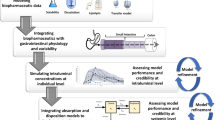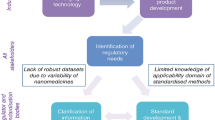No Heading
Purpose.
ME3229, an ester-type prodrug of a hydrophilic glycoprotein IIb/IIIa antagonist (ME3277), failed to show improved oral absorption. Okudaira et al. (J. Pharmacol. Exp. Ther. 294. 580–587, 2000) provided a piece of evidence that this is ascribed to an efflux system, distinct from P-gp and MRP2, that extrudes ME3277 formed from ME3229 in the intestinal epithelial cells. The aim of the present study is to examine the involvement of breast cancer resistant protein (BCRP/ABCG2) as a cause of low oral absorption of ME3229.
Methods.
The transport activity of ME3277 in the presence and absence of ATP was determined using a rapid filtration method with the membrane vesicles prepared from LLC-PK1 cells expressing BCRP. The plasma concentrations of ME3229 and its metabolites were compared between Bcrp1−/− mice and wild-type mice after a single-pass perfusion of small intestine with ME3229.
Results.
The ATP-dependent uptake of ME3277 was greater in BCRP-expressing membrane vesicles than that in the control vesicles. Furthermore, it was found that after intestinal perfusion with ME3229 for 60 min, the plasma concentrations of ME3277 and PM-5, a metabolite of ME3229, increased 2-fold and 3-fold, respectively, in Bcrp1 knockout mice. It is possible that BCRP acts synergistically with intestinal carboxylesterases.
Conclusion.
These results suggest that Bcrp1 plays an important role in the intestinal efflux of ME3277 and, probably, PM-10 and PM-11, metabolites of ME3229, and limits its BA after oral administration of ME3229.
Similar content being viewed by others
References
1. N. Okudaira, T. Tatebayashi, G. C. Speirs, I. Komiya, and Y. Sugiyama. A study of the intestinal absorption of an ester-type prodrug, ME3229, in rats: active efflux transport as a cause of poor bioavailability of the active drug. J. Pharmacol. Exp. Ther. 294:580–587 (2000).
2. N. Okudaira, I. Komiya, and Y. Sugiyama. Polarized efflux of mono- and diacid metabolites of ME3229, an ester-type prodrug of a glycoprotein IIb/IIIa receptor antagonist, in rat small intestine. J. Pharmacol. Exp. Ther. 295:717–723 (2000).
3. J. W. Jonker, J. W. Smit, R. F. Brinkhuis, M. Maliepaard, J. H. Beijnen, J. H. Schellens, and A. H. Schinkel. Role of breast cancer resistance protein in the bioavailability and fetal penetration of topotecan. J. Natl. Cancer Inst. 92:1651–1656 (2000).
4. J. W. Jonker, M. Buitelaar, E. Wagenaar, M. A. Van Der Valk, G. L. Scheffer, R. J. Scheper, T. Plosch, F. Kuipers, R. P. Elferink, H. Rosing, J. H. Beijnen, and A. H. Schinkel. The breast cancer resistance protein protects against a major chlorophyll-derived dietary phototoxin and protoporphyria. Proc. Natl. Acad. Sci. USA 99:15649–15654 (2002).
5. A. E. van Herwaarden, J. W. Jonker, E. Wagenaar, R. F. Brinkhuis, J. H. Schellens, J. H. Beijnen, and A. H. Schinkel. The breast cancer resistance protein (Bcrp1/Abcg2) restricts exposure to the dietary carcinogen 2-amino-1-methyl-6-phenylimidazo[4,5-b]pyridine. Cancer Res. 63:6447–6452 (2003).
6. M. Suzuki, H. Suzuki, Y. Sugimoto, and Y. Sugiyama. ABCG2 transports sulfated conjugates of steroids and xenobiotics. J. Biol. Chem. 278:22644–22649 (2003).
7. L. A. Doyle and D. D. Ross. Multidrug resistance mediated by the breast cancer resistance protein BCRP (ABCG2). Oncogene 22:7340–7358 (2003).
8. M. Muller, C. Meijer, G. J. Zaman, P. Borst, R. J. Scheper, N. H. Mulder, E. G. de Vries, and P. L. Jansen. Overexpression of the gene encoding the multidrug resistance-associated protein results in increased ATP-dependent glutathione S-conjugate transport. Proc. Natl. Acad. Sci. USA 91:13033–13037 (1994).
9. C. Kondo, H. Suzuki, M. Itoda, S. Ozawa, J. Sawada, D. Kobayashi, I. Ieiri, K. Mine, and K. Ohtsubo. Functional analysis of SNPs variants of BCRP/ABCG2. Pharm. Res. 21:1895–1903 (2004).
10. H. Yuasa, K. Matsuda, and J. Watanabe. Influence of anesthetic regimens on intestinal absorption in rats. Pharm. Res. 10:884–888 (1993).
11. R. M. Loria, H. L. Kayne, S. Kibrick, and S. A. Broitman. Measurement of intestinal absorption in mice by a double-label radioisotope perfusion technic. Lab. Anim. Sci. 26:603–606 (1976).
12. Y. Adachi, H. Suzuki, and Y. Sugiyama. Quantitative evaluation of the function of small intestinal P-glycoprotein: comparative studies between in situ and in vitro. Pharm. Res. 20:1163–1169 (2003).
13. J. Taipalensuu, H. Tornblom, G. Lindberg, C. Einarsson, F. Sjoqvist, H. Melhus, P. Garberg, B. Sjostrom, B. Lundgren, and P. Artursson. Correlation of gene expression of ten drug efflux proteins of the ATP-binding cassette transporter family in normal human jejunum and in human intestinal epithelial Caco-2 cell monolayers. J. Pharmacol. Exp. Ther. 299:164–170 (2001).
14. N. Mizuno, M. Suzuki, H. Kusuhara, H. Suzuki, K. Takeuchi, T. Niwa, J. W. Jonker, and Y. Sugiyama. Impaired renal excretion of 6-hydroxy-5,7-dimethyl-2-methylamino-4-(3-pyridylmethyl) benzothiazole (E3040) sulfate in breast cancer resistance protein (BCRP1/ABCG2) knockout mice. Drug Metab. Dispos. 32:898–901 (2004).
15. H. Suzuki and Y. Sugiyama. Role of metabolic enzymes and efflux transporters in the absorption of drugs from the small intestine. Eur. J. Pharm. Sci. 12:3–12 (2000).
16. L. Z. Benet, T. Izumi, Y. Zhang, J. A. Silverman, and V. J. Wacher. Intestinal MDR transport proteins and P-450 enzymes as barriers to oral drug delivery. J. Control. Rel. 62:25–31 (1999).
17. L. Z. Benet, C. L. Cummins, and C. Y. Wu. Transporter-enzyme interactions: implications for predicting drug-drug interactions from in vitro data. Curr. Drug Metab. 4:393–398 (2003).
18. J. Konig, A. T. Nies, Y. Cui, I. Leier, and D. Keppler. Conjugate export pumps of the multidrug resistance protein (MRP) family: localization, substrate specificity, and MRP2-mediated drug resistance. Biochim. Biophys. Acta 1461:377–394 (1999).
19. T. Satoh and M. Hosokawa. The mammalian carboxylesterases: from molecules to functions. Annu. Rev. Pharmacol. Toxicol. 38:257–288 (1998).
Author information
Authors and Affiliations
Corresponding author
Rights and permissions
About this article
Cite this article
Kondo, C., Onuki, R., Kusuhara, H. et al. Lack of Improvement of Oral Absorption of ME3277 by Prodrug Formation Is Ascribed to the Intestinal Efflux Mediated by Breast Cancer Resistant Protein (BCRP/ABCG2). Pharm Res 22, 613–618 (2005). https://doi.org/10.1007/s11095-005-2487-9
Received:
Accepted:
Published:
Issue Date:
DOI: https://doi.org/10.1007/s11095-005-2487-9




